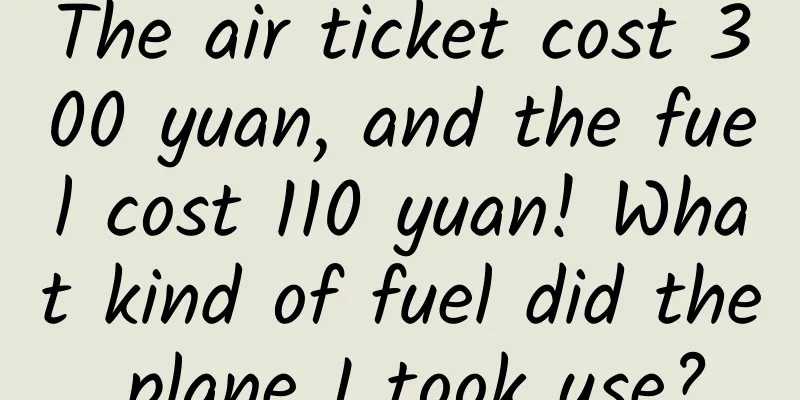The air ticket cost 300 yuan, and the fuel cost 110 yuan! What kind of fuel did the plane I took use?

|
With the rapid development of transportation such as airplanes and high-speed rail, we can start a special forces-style tour at any time. However, adhering to the principle of "save where you should save and spend where you should spend", everyone will probably compare before departure to see which is more cost-effective. Are you often attracted by special airfares, but instantly discouraged when you see the airport construction and fuel fees? Why are the fuel surcharges for airplanes so expensive? What kind of fuel is the plane I'm on fueling? The answer is neither gasoline nor diesel~ 01What kind of oil is purchased with the fuel surcharge? There are two types of aviation fuel, namely aviation gasoline and aviation kerosene (abbreviated as "jet fuel"). The former is generally used in aircraft using reciprocating engines, such as helicopters or communication machines, while the latter can be used in aircraft using jet engines, such as the commercial aircraft we usually take. Therefore, our fuel surcharge is directly linked to the price of aviation kerosene . Image source: baijiahao.baidu.com So what is aviation kerosene? Aviation kerosene is a fuel specially designed and produced for the aviation industry. It is also called jet fuel or jet kerosene. It is usually extracted from crude oil and is mainly composed of hydrocarbons of different fractions of alkanes (tīng), aromatic hydrocarbons and olefins. The components of aviation kerosene and ordinary kerosene are roughly the same. The difference is that aviation kerosene has been stripped of odorous sulfides on the basis of ordinary kerosene, so the alias of aviation kerosene is odorless kerosene. In addition, in order to meet the regulatory requirements of aviation fuel, it has also undergone hydrogenation, distillation, catalytic cracking, deoxygenation and other process treatments. In the production process, trace components such as antistatic agents, antioxidants, anti-wear agents, anti-icing agents, metal passivators, etc. are also mixed in a certain proportion. The composition and appearance of aviation fuel as specified in the national standard GB 6537-2018 Image source: Reference [2] 02 What is the difference between aviation kerosene, gasoline and diesel? To distinguish between jet fuel, gasoline and diesel, we must first talk about their preparation. Oil refining is a complex process. In simple terms: First, the crude oil is heated to a high temperature; the heated crude oil enters the fractionation tower - a vertical tower-shaped device with multiple horizontal trays inside; the crude oil heats up in the fractionation tower, and compounds with different carbon chain lengths begin to separate . Generally speaking, the shorter the carbon chain of the same type of hydrocarbon, the lower the boiling point and the easier it is to evaporate. Heavier compounds, such as kerosene and diesel, tend to condense in the lower part, while lighter compounds, such as gasoline, tend to condense in the higher part; collection devices are set up at different heights of the distillation tower to collect different fractions. These collection devices can separate a range of products, including gasoline, diesel, heating oil, jet fuel, propane, lubricating oil, asphalt, petrochemical products, etc. Image source: geologyscience.com Generally speaking, aviation kerosene, gasoline and diesel are all obtained through petroleum distillation, but there are obvious differences between the three. Gasoline is a fuel obtained from the light fraction of petroleum, generally composed of 4 to 12 carbon atoms; aviation kerosene is the heavier part extracted in the petroleum distillation tower, generally composed of 5 to 16 carbon atoms; diesel is a fuel obtained from the heavier fraction, generally composed of 8 to 21 carbon atoms. The above number of carbon atoms is an estimated value for general situations, and the actual number may be different. The density of gasoline, aviation kerosene and diesel increases in turn, flash point (the lowest temperature at which a material product forms a mixture with the outside air and flashes and burns immediately when it comes into contact with the flame, and materials or products with high flash points are not easy to catch fire): gasoline < aviation kerosene < diesel; boiling point : gasoline < aviation kerosene < diesel; volatility : gasoline > aviation kerosene > diesel; calorific value per unit volume (heat released by complete combustion of fuel): gasoline < aviation kerosene < diesel; compressibility : gasoline > aviation kerosene > diesel; viscosity : gasoline < aviation kerosene < diesel. Image source: Reference [2] In addition to oil refining, scientists and the aviation industry have also developed a process for preparing aviation kerosene from biomass. Through some special chemical treatments, combined with refining and standardized processing, some renewable materials, such as vegetable oil, animal fat, waste cooking oil, algae oil or wood fiber, can be converted into bio-jet fuel, that is, renewable aviation kerosene. Image source: news.abplive.com 03Why don’t airplanes use gasoline or diesel? First, compared to gasoline, aviation kerosene has a higher flash point and lower volatility, which makes it more stable to burn at high altitudes, low temperatures and low pressures. Safety is critical in the storage and handling of aviation fuel! Secondly, aviation kerosene is more cost-effective . Compared to gasoline, it has a higher calorific value, and a smaller amount can do the same amount of work, which is very important for long-distance flights and aircraft that need to carry a lot of fuel. What about diesel? At present, the vast majority of aircraft engines are turbine engines, and the premise of their operation is to fully atomize the fuel. Diesel has a high viscosity , and the atomization effect cannot meet the needs of turbine engines very well, so diesel cannot be used as aviation fuel. Image source: k.sina.com So how much fuel do we consume on a flight? The fuel consumption of an aircraft depends on many factors, including aircraft model, load weight, flight speed, altitude, range, wind speed and direction. Take the C919, my country's first jet mainline passenger aircraft independently developed in accordance with international airworthiness standards, with independent intellectual property rights, and completed its first commercial flight in May this year, for example. Its maximum fuel capacity is 19.56 tons (it is generally not fully fueled during actual flight. Think about why?), and its cruising speed is 0.785 Mach (about 962 kilometers/hour). It is estimated that its cruising process consumes about 2.8 tons of fuel per hour. Calculated based on the actual number of 168 people, the average fuel consumption per person per 100 kilometers is 2.3~2.4 L. (The average density of aviation kerosene is about 750kg/m3). C919 range load diagram: The cruising speed of C919 is 0.785 Mach and the maximum fuel load is 19560 kg. Source: Reference [5] Interested readers can also calculate the per capita fuel consumption of their own trip based on the aircraft model and seats. References [1] Collins C D. Implementing phytoremediation of petroleum hydrocarbons[J]. Phytoremediation: methods and reviews, 2007: 99-108. [2] GB 6537-2018 No. 3 Jet Fuel [3] "The Chemistry of Petroleum Products" https://chemed.chem.purdue.edu/genchem/topicreview/bp/1organic/coal.html [4] Zhai Yanliang, Lu Hongkong, Zhang Jian, et al. Research status of biomass-based aviation fuel production technology[J]. Chemical Technology, 2022. [5] "C919 Aircraft Characteristics for Airport Planning ACAP C919-SVV19-50009-00" Author: Ji Minghua, PhD, Shanghai Advanced Research Institute, Chinese Academy of Sciences, R&D Director, Shanghai Qingrui Food Technology Co., Ltd. Editor: Tinker Bell |
<<: To protect the environment, they put backpacks on cows to collect farts
>>: Stuffy nose? Your understanding of nasal congestion may be wrong...
Recommend
What does the Android system API level mean? What benefits can it bring to users?
According to the official WeChat account of Telec...
Surprise! The "supermoon" will be here for the Mid-Autumn Festival. This year, you can "feast your eyes"
The bright moon rises over the sea, and the world...
All the fun and useful apps from the App Store in the past ten years are here
Before Apple celebrates the 10th birthday of the ...
Why is the supermoon so big?
Don't doubt your eyes, sometimes the moon doe...
Detailed explanation of how to play on 7 major platforms including WeChat, Tik Tok, Xiaohongshu, etc., read it in one article!
In front are the old dominant players such as WeC...
Was there air pollution in ancient times? Let’s see what the ancients said!
Copywriter: Tianlan Editorial Office Edited by: R...
Three preparations you need to make before switching to operations
I heard you want to switch operations ? You have ...
Wuhan high-end tea sn, reliable sea selection factory, highly recommended by veteran drivers
Wuhan high-end tea drinking the best audition ven...
How much does it cost to be an agent for a homestay mini program in Hengshui?
Why should you be an agent for WeChat Mini Progra...
Don’t take heel pain lightly, it may be caused by these 3 diseases!
This article was reviewed by Ao Rongguang, MD, Ma...
International Day for the Elimination of Domestic Violence丨Beating is love, scolding is love? Stop making excuses! These are all domestic violence!
About personal safety protection order The person...
Four steps of community operation: Taking the operation of King of Glory group as an example
When operating a community , the following steps ...
Is it a person or a person? Who "tampered" with your memory?
Recently, a great debate on memory has been spark...
SMIC Financial Report: Revenue in 2024 Reaches a New High of 58.68 Billion Yuan, Capacity Utilization Rate of 85.6%
According to recent news, SMIC announced its unau...
Can pushing poop too hard lead to sudden death?
Have you ever had this experience: in the toilet,...









